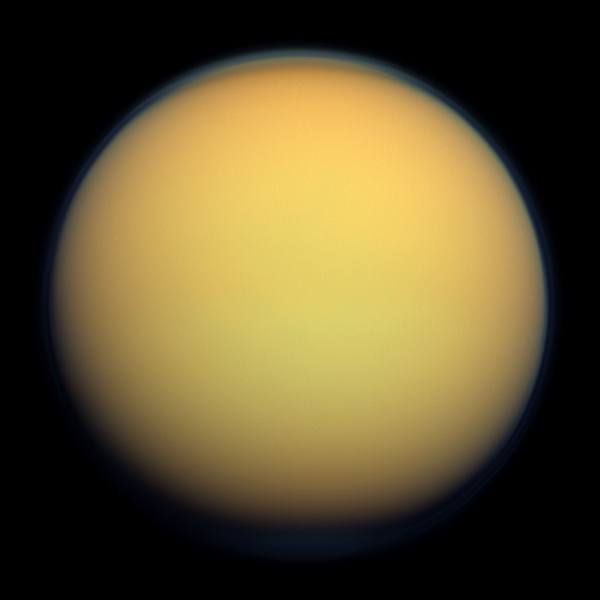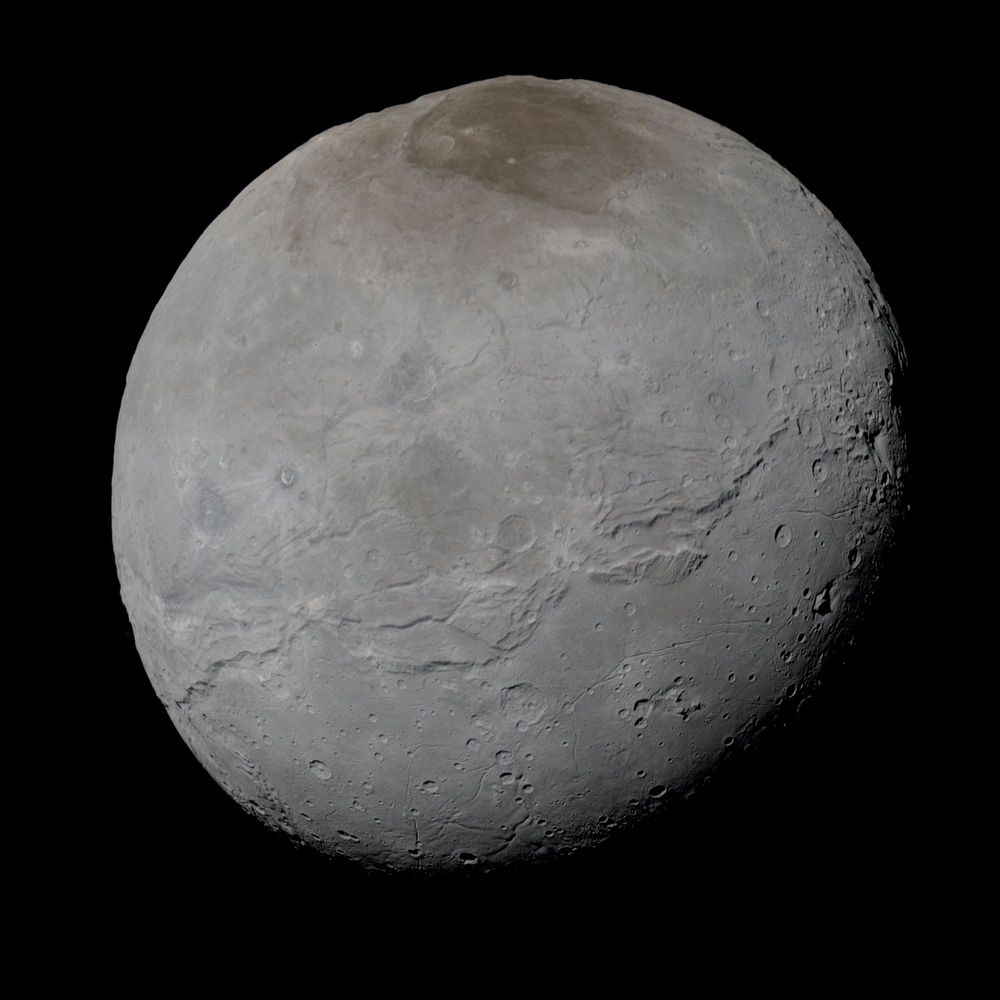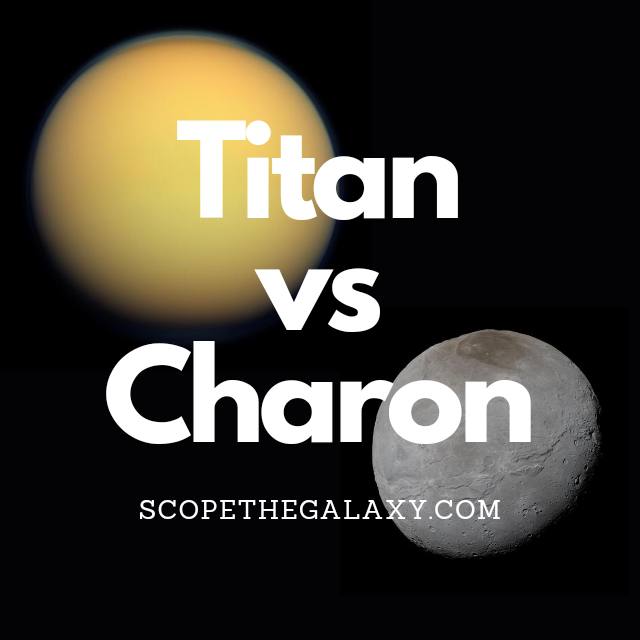*This post may contain affiliate links. This means we may make a commission if you purchase an item using one of our links*
The main differences between Titan and Charon is that Titan is the 2nd largest moon with a diameter of 5,150km whilst Charon is the 12th largest with a diameter of 1,212km, Titan orbits Saturn whilst Charon orbits Pluto and Titan has an atmosphere and water cycle comparable to that of Earth whilst Pluto does not.
There are numerous other differences between these two so, continue reading for a more detailed look at each of these natural satellites along with their similarities and differences.
What Is The Moon Titan?
Table of Contents

Titan is Saturn’s largest moon and the second biggest moon in the entire solar system, with a diameter of 5,150km. This would make it even larger than the planet Mercury which is only 4,879km, and significantly larger than Pluto also.
As a result, Titan’s gravitaional strength stands at around 1.352 m/s²
It is the only natural satellite in our solar system that is composed similarly to Earth, where it has a thick atmosphere (1.19 times that of Earth) made primarily of nitrogen (95%) along with smaller amounts of methane (5%).
It has rivers and lakes on its surface along with a water cycle very similar to that of Earth, where essentially water evaporates and eventually lands on the satellites surface.
Therefore, much like Earth, Titan has a terrestrial based body but, there is a difference in their atmospheric pressure. The pressure on Titan’s surface is around 60% greater than that of Earth’s surface but, it isnt nearly as dense.
Nevertheless, it is still far denser than most other bodies at 1.88 g/cm³. As a result, Titan’s mass is 1.345×10^23 kg.
In regards to its temperature, Titan is on the colder side where it averages around -179 degrees Celsius whilst its core’s temperature is actualluy very cold in comparison to other entities falling between 226 – 526 degrees Celsius.
As Saturn is the 6th farthest planet from the Sun, it will take Titan roughly the same amount of time to orbit the Sun, which would fall around 29.4 years.
It takes Titan 15 days and 22 hours to orbit Saturn. A day is 15 days and 22 hours also as it is tidally locked to the gas giant.
What Is The Moon Charon?

Charon is the largest of Pluto’s moons, first discovered on 22nd June 1978. The surface of this icy world is frozen with nitrogen and methane ice; it may also hold some water ice. While Pluto possesses a reddish hue, Charon is closer to a neutral shade of grey; this suggests the two bodies have different compositions.
Scientists named this moon after the mythical ferryman, Charon, who once carried souls across the Acheron river. This river is one of five legendary rivers that could lie beneath the surface of Pluto.
The formation of Charon remains something of a mystery to scientists. However, this moon may have formed around 4.5 billion years ago when an object traveling at immense speed collided with Pluto. Its average distance from the Sun is approximately 3.6 billion km.
Charon is almost half the size of its planet at 1,212km, where scientists refer to these two bodies as a “double dwarf planet system,” and the chilly temperatures vary from minus 23 to minus 258 degrees Celsius.
Charon takes 153 hours to orbit its planet at an average distance of 19,640km, and it is tidally locked, meaning the same side of the moon always faces Pluto. Pluto also experiences a tidal lock to Charon, so the same two sides always face one another.
Among the fascinating features of this ice moon are the ice volcanoes that could exist on the surface. Observations from the Gemini observatory suggest that Charon could have a form of cryovolcanism known as ice-particle geysers.
The frigid world also has a canyon between seven and nine kilometers deep. (To put that into perspective, Mount Everest has a height of 8.8km).
How Are Titan And Charon Similar?
As both are natural satellites, Charon and Titan do share a few similarities, which includes the following:
- Both have a hotter central core.
- Both have a rocky, terrestrial surface.
- Both are spherical in shape.
- Neither have rings surrounding them.
- Both are tidally locked to their planet.
- Both orbit their planet in an elliptical pattern.
- Neither have a magnetic field.
- Neither have tectonic plates.
Differences Between Titan And Charon
In regards to the differences between the two, they include the below:
- Titan is the bigger of the two with a diameter of 5,150km whilst Charon has a diameter of 1,212km.
- Charon orbits Pluto whilst Titan orbits Saturn.
- Charon has a very thin exosphere whilst Titan’s atmosphere is 1.19 times as thick as Earth’s and is composed of nitrogen and smaller amounts of methane.
- Titan has a water cycle similar to that of Earth whilst Charon does not have a water cycle.
- A day on Charon takes 153 hours whilst a Titan day is 15 days and 22 hours.
- It takes Charon 153 hours to orbit Pluto whilst Titan orbits Saturn in 15 days and 22 hours.
- Titan orbits Saturn at an average distance of 1.2 million km whilst Charon is 19,640 km from Pluto.
- Titan’s axial tilt is 27 degrees whilst Charon’s axial tilt is close to 0.
- Charon’s average temperature is around -23 to -258 degrees Celsius whilst Titan’s average temperature is -179 degrees Celsius.
- Titan’s density is 1.88 g/cm³ whilst Charon’s density is 1.71 g/cm³.
- Titan’s mass is 1.345×10^23 kg whilst Charon’s mass is 1.58 × 10^21 kg.
- Charon’s gravitational strength is 0.288 m/s² whilst Titan’s is 1.352 m/s².
Summary
Although both Charon and Titan are natural satellites and their basic physical composition is terrestrial in nature however, whether it be in regards to size, mass, temperature, atmospheric composition and beyond, Titan and Charon are still distinctly different in how the operate when orbiting their respective planets.

